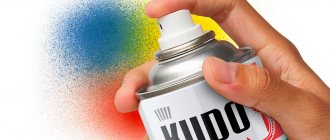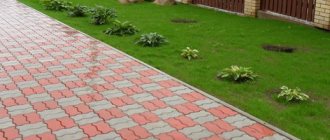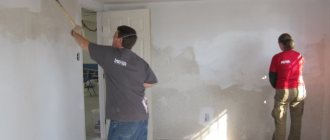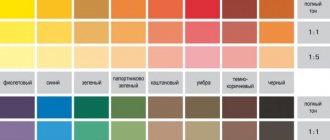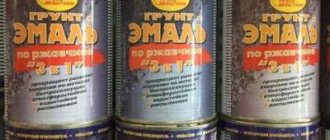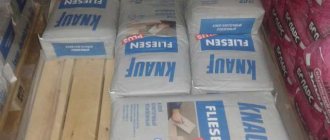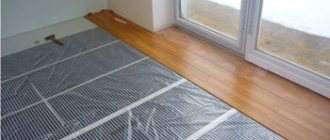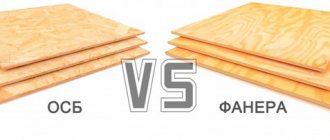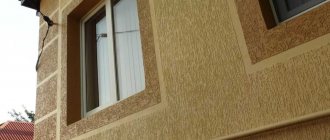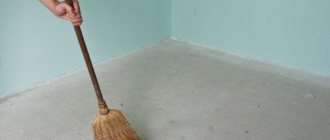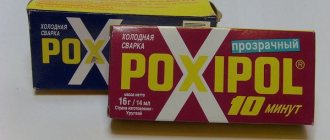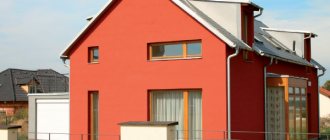Latex primers are mixtures for preliminary preparation of surfaces for finishing. The key advantage of latex primers is that they are universal, that is, they are suitable for working with different types of surfaces: concrete, plaster, wood, metal.
By their structure, latex primers are an aqueous dispersion with specialized additives and polymers included in the composition. The use of additives in the soil formula helps give it the necessary beneficial characteristics - for example, antiseptic properties or the ability to penetrate deeply into the base. Latex-based primers are ideal when there is a need to hide stubborn stains - from grease, soot, rust, tar and even petroleum products.
Latex primer solutions are easy to apply; the primer easily applies to smooth and slippery surfaces, provides strong adhesion of the layers, and quickly absorbs and dries.
Latex primer: composition and properties of the material
Universal latex primers are used for application on different types of surfaces - concrete, wood, plaster, brick, plasterboard. With the help of a specialized composition it is possible to obtain the following effects:
- make the base more durable;
- improve protection from external factors;
- increase the adhesion parameters of the base and finishing.
Latex compounds are used for interior work. They can be used to process various porous surfaces. Such substances are well absorbed and penetrate deeply into the structure. Thanks to this, it is possible to save subsequent finishing materials. It is also permissible to use latex primers to level the joints of plasterboard boards and plastered surfaces.
If the composition is applied to the facade of a building, then it should subsequently be covered with latex paint. This primer forms a durable yet thin protective film that does not become covered with bubbles and blisters.
The structure of latex primers is an aqueous dispersion that contains additives and polymers. The use of components in the formula helps to give it the required properties. Latex mixtures allow you to hide difficult stains. They are characterized by ease of application, quickly absorb and dry.
Expert opinion
Zakharova Irina Yurievna
Cleaning professional with 15 years of experience. Our best expert.
Ask a Question
Latex-based primers can have different types - universal, antiseptic, deep penetration.
The specific variety should be chosen taking into account the purposes of preliminary priming. The key characteristics of the material include the following:
- Ability to withstand low temperatures. Thanks to this, the substances can be used for external and internal work.
- Can be used on loose and porous surfaces, as well as on old paint or unprepared surfaces. This is due to the ability of the material to penetrate deeply into the base layers and strengthen them.
- High moisture resistance parameters. Therefore, primers can be applied in rooms with high humidity. They are used to treat kitchens, saunas, and bathrooms.
- Universal purpose. Primer mixtures can be used on different surfaces.
- Safety. The mixtures are not characterized by a strong aroma or toxic substances in the composition.
- Reliable protection against fungi and mold.
- High degree of adhesion with subsequent layers of finishing.
See also
6 suitable types of paint for a concrete fence and step-by-step application
Another important property of such soils is rapid drying. On average, the substance dries within 2 hours.
Application in repair
The scope of application of latex primers is quite extensive and they can be used for working with indoor surfaces, carrying out facade and street repair and finishing work.
Latex-based primers can be used to treat untreated and painted wooden surfaces; they can also be used with old wood that has been exposed to open conditions for a significant period of time.
Latex primer mixtures can be used on wood bases, but if you have to work with an untreated wood base that releases resinous substances, it is better to choose an alkyd solution for priming.
We use latex primer for the preliminary preparation of cement, concrete and plastered surfaces. The solution will penetrate into the pores of the base as deeply as possible and qualitatively strengthen it from the inside, thereby preventing the unwanted process of shedding. Since the material dries quickly, it is ideal for use where “fresh” surfaces need to be quickly prepared for painting or cladding.
Latex-based solutions are also suitable for working with metal surfaces: the use of primer will help protect the base from corrosion processes and rust.
Since latex primers are universal, they are suitable for treating all types of premises. This quality of primer mixtures helps to save not only on the consumption of finishing materials, but also on the purchase of the composition itself: there is no need to purchase a separate solution for each surface.
Operating principle and scope of application
Latex primer helps achieve the following results:
- Strengthen adhesive characteristics. This is the most important feature that helps improve the quality of the coating. The polymer layer is securely bonded to the treatment surface - concrete, brick, wood, plasterboard or metal. It also holds the applied cladding well, including adhesive and paint coatings.
- Reduce the cost of finishing materials. Despite the fact that wallpaper or tiles have a hard and dense structure, they are fixed with liquid glue.
- Strengthen the surface layer. Latex film seals microcracks well on concrete and brick surfaces. In addition, it helps to increase the strength of the cardboard base. Thanks to this, it does not get wet under the influence of paints and varnishes.
- Achieve waterproofing. The pores of the treated surfaces are filled during the application of polymers.
- Neutralize the color spectrum of the base. To do this, just add white dye to the primer mixture.
Latex primers can be applied to the following types of surfaces:
- concrete;
- brick;
- cardboard;
- plastered;
- plasterboard;
- aerated concrete.
Quite often the substance is used for tongue-and-groove slabs, cement-sand screeds, gypsum surfaces, and cinder blocks.
Why is it important to prime foundations?
Professionals say that before performing finishing work, it is imperative to prime the surfaces so that the finish can be used for a long time and retain its attractiveness for a long time. Here are the main advantages of using latex primer:
- increase in adhesion characteristics. When a good primer dries on the surface and paint and varnish materials are applied on top of it, small particles of this material reliably adhere to the primed surface, thereby ensuring excellent adhesion. And it doesn’t matter what kind of base is covered with soil, it can be wood, concrete, brick, foam concrete, a layer of plaster or a painted surface. A latex-based primer enhances adhesion on any type of substrate;
- reducing the consumption of finishing materials. During puttying or painting, quite a lot of this finishing product is often consumed, much more than indicated in the instructions. This occurs because the base is very porous and quickly absorbs material. And if you first use a latex primer, then all the pores, even the smallest ones, are reliably filled, the base is saturated, therefore, subsequently, when applying paints and varnishes, their consumption is significantly reduced, paint or glue is consumed exactly as much as the manufacturer indicated in the instructions;
- the foundation is strengthened. There are small cracks on any floors, walls or ceilings, and if they are not repaired, the service life of the finishing materials will be reduced. Thanks to the application of a latex primer, all surface defects are eliminated, the base becomes strong and strengthened, so the putty or paint will last much better and longer;
- a waterproofing layer is created. If you do not treat the base with latex primer, small droplets of water may form on the surface, especially in winter. This moisture has a detrimental effect on the finish; thanks to the primer, the base acquires good protection from high humidity in the room, so fungi and mold do not appear on the walls and ceiling;
- Latex primer on concrete surfaces helps cover up the dark shade of concrete. If you don't use a primer, the gray color will still be noticeable, but if you add white pigments to the primer, the concrete walls or ceilings will become much lighter, so it will be much easier to cover up the dark color with paint.
Advantages and disadvantages of latex primer
The primer composition must correspond to the type of base on which it is applied. This feature should definitely be taken into account when choosing a substance. Thus, for treating porous substrates it is allowed to use a deep penetration primer. Also on sale are special mixtures for wallpaper or anti-corrosion substances for applying to metal surfaces. Latex primer has the following advantages:
- Deep penetration into porous materials. Since the liquid saturates the base well, its strength increases.
- Environmental cleanliness and safety. The soil contains exclusively natural ingredients. Therefore, during application and further use of the coating, no harmful elements enter the air.
- Significant reduction in base porosity. Latex primer saturates the surface of the material. Thanks to this, it does not absorb substances used for finishing as much.
- Fast drying. Latex substances dry within 2 hours. This helps save time on repairs. After just a couple of hours, the coating can be painted, puttyed or plastered.
- Increased adhesion index. The primer holds any topcoat well.
- Giving the surface water-repellent characteristics. This prevents the absorption of moisture and water. As a result, fungi and mold do not develop in the room. Latex substances are allowed to be used in rooms with high levels of humidity - in the bathroom, toilet, kitchen.
- Economical consumption. On average, it is 100-120 grams per 1 square meter. With rapid absorption of liquid by the surface, the maximum cost is 200 grams.
See also
Areas of application of zinc white and what it is, types of paints
Why latex
Most often you can find two large groups of priming solutions:
- solvents in their composition ;
Example of an alkyd primer
- Latex, created on a water basis .
Deep penetration latex primer in a bucket
The second group has a number of advantages that personally tip my hand in favor of their use, at least in everyday life.
Advantages
Before moving directly to the description of the advantages of the substance in question, I want to explain what the difference is between latex and acrylic primers. If you don’t go into chemical formulas, then nothing : the presence of latex or acrylic in the soil gives it absolutely identical properties. Keep this in mind when shopping to avoid confusion.
And now, in fact, the advantages themselves:
- Complete safety during use and after hardening . All that acrylic or latex primer is capable of releasing into the air is only water vapor, which cannot harm children, allergy sufferers, or pets;
Even ceilings in a child’s room can be treated with a latex-based primer without fear for the child’s health.
- Significant increase in resistance to dampness . “Liquid rubber,” as I noted above, qualitatively clogs the pores of the material being processed, eliminating the possibility of the formation and spread of fungal spores in its structure;
Latex antiseptic and hydrophobizing primers do an excellent job of protecting against excessive humidity
- High hardening speed . Most compositions form a durable polymer film within two hours after applying them to the surface to be treated. This allows repairs to be carried out without significant interruptions;
- Relatively low price . Refusal to use expensive solvents also benefited the final cost of the product. Water is much cheaper.
Regarding the last point, I don’t want to be unfounded here and will give specific examples of latex primers that can be found today at specialized points of sale:
Offers from manufacturers
- "Tex Pro Moisture Protection":
| Parameter | Description |
| Firm- | |
| Country of manufacture | Russia |
| Surface to be processed |
|
| Density indicator | 1000 g/l |
| Container weight | 9000 g |
| Binder | Latex |
| Application tools |
|
| Type of work | Domestic |
| Price | 2136 rubles |
Latex-based primer “Tex Profi Moisture Protection”
- "Optimum":
| Parameter | Description |
| Firm- | |
| Country of manufacture | Russia |
| Diluent | Water |
| Density indicator | 1000-1100 g/l |
| Container weight | 10000 g |
| The amount of dry residue | 5% |
| Binder | Latex |
| Application tools |
|
| Type of work | Domestic |
| Curing period | 40 minutes |
| Approximate consumption | 1 kg per 5-14 m2 |
| Price | 540 rubles |
Sample of penetrating latex primer “Optimum”
- "Prospectors":
| Parameter | Description |
| Country of manufacture | Russia |
| Diluent | Water |
| Container weight | 5000 g |
| Binder | Latex |
| Application tools |
|
| Type of work | Domestic |
| Curing period | 60 minutes |
| Approximate consumption | 100-200 ml per 1 m2 |
| Price | 215 rubles |
Sample of latex primer “Prospectors”
- Seal Grip:
| Parameter | Description |
| Firm- | |
| Country of manufacture | Russia |
| Surface to be processed |
|
| Diluent | Water |
| Alkaline resistance | 13 ph |
| The amount of dry residue | 2% |
| Binder | Latex |
| Application tools |
|
| Type of work | Domestic |
| Curing period | 60 minutes |
| Approximate consumption | 3.8 l per 37-46 m2 |
| Volume | 3.8 l |
| Price | 1900 rubles |
Sample of “Seal Grip” latex primer
- "Sniezka":
| Parameter | Description |
| Firm- | |
| Country of manufacture | Poland |
| Surface to be processed |
|
| Diluent | Water |
| Density indicator | 1.6 g/cm3 |
| Container weight | 3000 g |
| The amount of dry residue | 5% |
| Binder | Latex |
| Application tools |
|
| Type of work | Domestic |
| Curing period | 120 minutes |
| Price | 168 rubles |
Sample of latex primer “Sniezka”
Features of use
In order for a substance to give the desired result, it is important to use it correctly. In this case, it is worth preparing the surface.
Surface preparation
Before applying the primer, you must do the following:
- Prepare all necessary tools and materials. Applying latex primer may require rollers, brushes, trays and primer containers. It is also recommended to use rags, newspapers and plastic wrap.
- To prepare the base, it is recommended to thoroughly clean it. All rust must be removed from metal surfaces, and the walls must be cleaned of dust with a brush. It is also recommended to wash off greasy stains. If necessary, you should use antiseptic agents that protect surfaces from rotting. After this, the coating must be dried.
- Open up the cracks and treat them with plaster mortar. It is also permissible to use a specialized composition.
- Cover furniture and floors with plastic wrap.
- Monitor humidity and temperature parameters. Temperatures should be at least +10 degrees, and humidity – up to 75%.
Calculation of consumption and preparation of working solution
The consumption of the primer mixture is influenced by many factors - the type of base, the presence of pores, the number of layers that are planned to be applied. The average cost of latex substance is 150 grams per 1 square meter.
To achieve the formation of a durable film on the base, the solution must be used in 2-3 layers. In this case, each subsequent layer can be applied only after the previous one has completely dried.
After preparing the surface, it is recommended to start preparing the solution. It is important to follow the manufacturer’s recommendations. The primer must be mixed well before application.
See also
Description of Akterm Concrete and types of compositions, rules of application and analogues
Applying a primer layer
To cover the surface with a primer layer, it is recommended to do the following:
- Pour some primer into a tray or small container.
- Use a brush to treat all hard-to-reach places. These include joints between walls and ceiling, between walls and floor, and areas near radiators. It is also recommended to pay attention to window slopes and doorways.
- Continue processing the surface with a roller. To prevent the soil from draining, it is important to squeeze out the coat of the tool in the pan.
To create a durable layer, the primer must be applied 2 times. Only in this case will it be possible to saturate the surface pores with the substance.
How long does it take for primer to dry?
At room temperature, the primer dries in 30 minutes to 2 hours.
Precautions and safety precautions
When using soil, it is important to adhere to a number of rules:
- When working at height, create a strong structure. For this purpose, it is recommended to use special scaffolding.
- Be sure to wear protective clothing and closed shoes. It is also recommended to use a hat, respirator, and safety glasses.
- You should not carry out work if you are feeling unwell.
- If the mixture gets into your eyes, rinse them with plenty of water.
- Keep the composition out of the reach of children.
Preparing the base and applying primer
Before priming, be sure to prepare the surface. Preparation includes the selection of the necessary tools, such as a brush, roller, container for primer, and a rag to remove excess liquid.
To prepare the base, all rust, mold, oil, grease stains, dirt and dust must be removed from it. If necessary, the walls are treated with antiseptics. After preparation, the base must dry. If there are cracks, they are first opened, after which they are sealed either with plaster or special mixtures.
If there is furniture in the room, it needs to be protected with plastic film; all other surfaces, including floors, are also protected with polyethylene, because stains from the primer mixture are quite difficult to remove. In addition, it is important to protect your eyes, head and skin by using glasses, a hat and thick clothing.
It is necessary to prime at a temperature of at least 10 degrees, and at an air humidity of no more than 75-80%. The latex primer is poured into a tray, after which large areas are treated with a roller, and the primer is applied to hard-to-reach places with a brush. Experts recommend priming with two layers, in which case the surface will be completely saturated with the primer mixture. Each subsequent layer is applied only after the previous layer has completely dried. If soil gets on your skin or eyes, they should be rinsed immediately with tap water.
Types of universal primer mixtures
Acrylic primer mixture can be used to cover the surface:
- brick;
- concrete;
- plastered;
- putty;
- plasterboard;
- wooden.
Acrylic primers dry quickly, dissolve with water, and have no toxic odors. Surface and deep penetration primers are produced on the basis of acrylic. They are not used for treating metal surfaces, since metal needs soils that can protect against corrosion.
Acrylic-latex primers are used for exterior finishing work. Their advantageous properties include the fact that they can be applied to the surface to be treated at subzero ambient temperatures. Latex and acrylic based primer can be used before painting the surface:
- Chipboard and wood;
- bricks;
- aluminum;
- bricks;
- plasters;
- galvanized metals.
This primer is advantageous in that it can be applied to old paint and unprepared surfaces. It is very easy to choose the required color, since this primer mixture is available in a wide range of colors and comes in a wide variety of shades.
Types of primers
Acrylic
It is also called emulsion and is intended for almost any surface, including:
- brick;
- concrete;
- plastered;
- putty;
- wooden;
- plasterboard.
They are not used on metal, since most such compositions do not have an anti-corrosion component. Among the advantages, we should highlight the ease of use of acrylic primers, since they can be diluted with plain water.
The drying speed is also high - only 2-4 hours, depending on the ambient temperature. Due to the absence of a strong chemical odor, the material is very convenient to use in residential areas.
Both surface and deep penetration primers are made on the basis of acrylic.
Acrylic-latex primer for exterior use
- Facade primer based on a mixture of latex and acrylic Super Spec is applied before treating the surface of latex paint for exterior use and can be used at low temperatures. It forms a film that is resistant to bubble formation.
Acrylic and latex primer - what is the difference?
Many people wonder which primer is better - latex or acrylic? It would seem that both materials are intended for preparatory work when processing bases. But you can decide which one to choose only by studying the manufacturer’s instructions.
When choosing, you should take into account that the difference between these two materials is that acrylic will not protect against corrosion, while latex will provide this protection. In addition, the latter can still be used in damp areas. The materials also differ in composition.
Advice! If you have any doubts when choosing, it is recommended to contact a sales consultant and find out exactly how one and another product differs.
